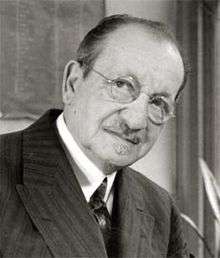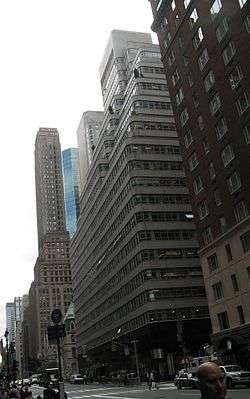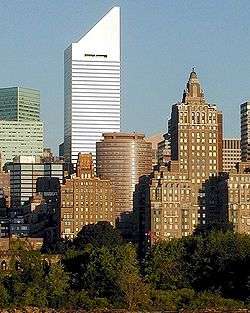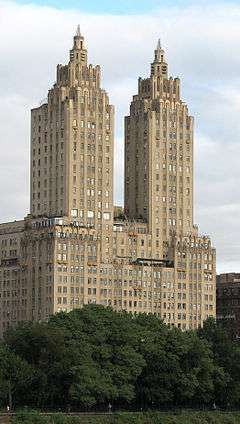Emery Roth
| Emery Roth | |
|---|---|
 | |
| Born |
1871 Sečovce, Austria-Hungary |
| Died |
August 20, 1948 New York City, New York, U.S. |
| Residence | Austria-Hungary, United States |
| Citizenship |
|
| Occupation | Architect |
| Notable work |
Hotel Belleclaire (1903) Ritz Hotel Tower (1925) The Eldorado (1929–31) The San Remo (1930) The Ardsley (1931) 2 Sutton Place South (1938) 300 East 57th Street (1947) |
| Spouse(s) | Ella Grosman |
| Children | Julian, Richard, Elizabeth, Kathrin |
Emery Roth (Hungarian: Róth Imre, 1871 – August 20, 1948) was an American architect of Jewish descent who designed many of the definitive New York City hotels and apartment buildings of the 1920s and 1930s, incorporating Beaux-Arts and Art Deco details. His sons continued in the family enterprise, largely expanding the firm under the name Emery Roth & Sons.
Biography

Born in Sečovce (Hungarian: Gálszécs), Austria-Hungary (now Slovakia) to a Jewish family, he emigrated to the United States at the age of 13 after his family fell into poverty upon his father's death. He began his architectural apprenticeship as a draftsman in the Chicago offices of Burnham & Root, working on the World's Columbian Exposition of 1893. At the Exposition Roth also designed one of his first solo projects; a pavilion that housed a chocolatier.[1] There he met Richard Morris Hunt, who was impressed with his skills and invited Roth to work in his office in New York. Following Hunt's premature death in 1895, Roth moved to the office of Ogden Codman, Jr., a designer and decorator with a Newport clientele. In the interwar years, the firm of Emery Roth delivered some of the most influential examples of architecture for apartment houses in the at-the-time fashionable beaux art-style, especially in Manhattan. In 1938, Roth included his sons Julian and Richard as partners.
Buildings designed
| Building | Year | Location | Notes |
|---|---|---|---|
| The Saxony | 1899-1900 | 250 West 82nd Street | |
| Hotel Belleclaire | 1903 | Broadway | |
| The Adath Jeshurun of Jassy synagogue | 1903 | 58 Rivington Street | |
| 601 West End Avenue | 1915 | 601 West End Avenue | |
| The First Hungarian Reformed Church | 1915 | East 69th Street | |
| 1000 Park Avenue[2] | 1916 | Park Avenue and East 84th Street | |
| 151 East 80th Street | 1922 | 151 East 80th Street | |
| The Whitby | 1924 | 325 West 45th Street | |
| 110 West 86th Street | 1924 | 110 West 86th Street | |
| Chester Court[3][4] | 1924 | 201 West 89th Street | |
| 243 West End Avenue | 1925 | West End Avenue (Manhattan) | |
| Mayflower Hotel | 1925 | 15 Central Park West | demolished in 2004 |
| 221 West 82nd Street | 1925 | 221 West 82nd Street | |
| 930 Fifth Avenue | 1925 | 930 Fifth Avenue | |
| Ritz Hotel Tower | 1925 | 109 East 57th Street | With Carrère and Hastings. New York's first residential skyscraper introduced terraces at the setback levels. |
| 41 West 96th Street | 1926 | 41 West 96th Street | |
| 65 Central Park West | 1926 | 65 Central Park West; Lincoln Square | |
| The Alden | 1927 | 225 Central Park West; Upper West Side | |
| The Oliver Cromwell | 1927 | 12 West 72nd Street | |
| Warwick Hotel | 1927 | 65 West 54th Street | |
| Hotel Benjamin | 1927 | 125 East 50th Street | |
| Manchester House | 1928 | 145 West 79th Street | |
| The Eldorado | 1929–1931 | Central Park West Historic District | |
| The Beresford | 1929 | 211 Central Park West | |
| 15 West 81st Street | 1929 | 15 West 81st Street | |
| 300 West 23rd Street | 1929 | 300 West 23rd Street | |
| 35 Prospect Park West | 1929 | Prospect Park; Brooklyn | |
| Hotel St. George | 1930 | Brooklyn Heights | |
| Hotel St. Moritz | 1930 | 50 Central Park South | |
| 993 Fifth Avenue | 1930 | 993 Fifth Avenue | |
| 784 Park Avenue | 1930 | 784 Park Avenue | |
| The San Remo | 1930 | 145 and 146 Central Park West | The first of the twin-towered residential skyscrapers. |
| The Ardsley | 1931 | 320 Central Park West | Roth's outstanding Art Deco residential skyscraper. |
| 275 Central Park West | 1930–1931 | 275 Central Park West | |
| 299 West 12th Street | 1931 | 299 West 12th Street | |
| 140 East 28th Street | 1932 | 140 East 28th Street | |
| 888 Grand Concourse | 1937 | 888 Grand Concourse | |
| 880 Fifth Avenue | 1948 | 880 Fifth Avenue | 1938
2 Sutton Place South |
| 41 West 96th Street | 41 West 96th Street | ||
| 310 West End Avenue | 310 West End Avenue | ||
| The Normandy | 1938 | 140 Riverside Drive | Last of the twin-towered residences, and Roth's choice for his retirement apartment. |
| Shenandoah Apartments | 10 Sheridan Square |
Emery Roth & Sons
Despite the fact that Roth's sons, Julian and Richard, had joined the firm many years earlier, it was not until 1947 that the firm's name was changed to Emery Roth & Sons, approximately one year before Roth's death.[5] Julian (1901–1992) specialized in construction costs and building materials and technology, while Richard (1904–1987) was named the firm's principal architect. In the 1950s and 1960s Emery Roth & Sons became the most influential architectural firm in New York and contributed substantially in changing the appearance of Midtown and Lower Manhattan. In that particular period of time Emery Roth & Sons designed dozens of speculative office buildings, mostly with curtain wall facades, which soon became a ubiquitous feature of the city.[6] Beginning in the mid-1960s, the firm was also hired as associate architects in large-scale projects like the Pan Am Building (1963), the World Trade Center (1966–1973) and the Citicorp Center (1977). In the early 1960s, Richard Roth's son, Richard Roth, Jr. (b. 1933) became the third generation to join the firm, eventually rising to chief architect CEO and shareholder. As the firm expanded and diversified over six decades, it remained a family business through the 1990s. In 1988 Richard Roth Jr's daughter Robyn Roth-Moise joined the firm as comptroller. Richard Roth Jr's son Richard Lee Roth joined the firm in 1982 and became the chief specification writer for Emery Roth & Sons. Both retired from the firm when Richard Roth Jr retired and was replaced as the company's CEO in 1993 by Robert Sobel, Roth's cousin.[7] But only three years later, in 1996, the firm ceased to operate, apparently because of financial distress.[8] Emery's great-grandson Richard Lee Roth currently works in the architectural profession and resides in South Florida.
The extensive architectural records and papers of both Emery Roth and Emery Roth & Sons are now held in the Department of Drawings & Archives at the Avery Architectural and Fine Arts Library at Columbia University.
Work by Emery Roth & Sons






- 300 East 57th Street (1947)
- Paris Theater & Office Building (1948)
- 715 Park Avenue (1949)
- 945 Fifth Avenue Apartments (1949)
- Look Building, 488 Madison Avenue (1949)
- 40 Park Avenue (1950)
- 45 East End Avenue Apartments (1950)
- 85 East End Avenue, NE corner of E83rd St (1950)
- 575 Madison Avenue (1950)
- 2 Fifth Avenue (1952)
- 380 Madison Avenue (1953)
- 30 Park Avenue (1954)
- 555 Fifth Avenue (1954)
- 589 Fifth Avenue (1954)
- National Distillers Building (1954)
- 430 Park Avenue (Renovation) (1954)
- Baruch Houses (1954–1959)
- 460 Park Avenue (1955)
- Bank of Montreal Building (1955)
- Colgate-Palmolive Building (1955)
- Davies Building (1955)
- 156 William Street (1956)
- 415 Madison Avenue (1956)
- 485 Lexington Avenue (1956)
- 1430 Broadway (1956)
- 123 William Street (1957)
- 630 Third Avenue (1958)
- 750 Third Avenue (1958)
- 400 Madison Avenue (1958)
- General Reinsurance Building (1958)
- 100 Church Street (1958)
- 166 East 63rd Street (Beekman Town House) (1959)
- 2 Broadway (1959)
- 10 Lafayette Square (Buffalo, New York) (1959)
- 355 Lexington Avenue (1959)
- The Bronx High School of Science (1959)
- Harriman National Bank Building (1959)
- Lorillard Building (1959)
- East Ohio Building (Cleveland, Ohio) (1959)
- 10 East 70th Street Apartments (1960)
- 80 Pine Street (1960)
- Mutual of America Building (1960)
- 850 Third Avenue (1961)
- Pfizer Building (1961)
- Diamond National Building (1961)
- 60 Broad Street (1962)
- 215 East 68th Apartments (1962)
- 1180 Sixth Avenue (1962)
- Bankers Trust Building (1962)
- Tower East Apartments (1962)
- Hanover Bank Building (1962)
- 1212 Sixth Avenue (1963)
- 250 Broadway (1963)
- Neuberger Berman Building (f/k/a Burroughs Building) (1963)
- 845 Third Avenue (1963)
- AXA Financial Center (1963)
- MetLife Building (Pan Am Building) (1963)
- Donaldson, Lufkin & Jenrette Building (1963)
- 277 Park Avenue (1964)
- 641 Lexington Avenue (1964)
- Harcourt, Brace & World Building (1964)
- Sterling Drug Company Building (90 Park Avenue) (1964)
- 600 Madison Avenue (1965)
- Bankers Trust Annex Building (1965)
- Xerox Building (1965)
- MGM Building (1965)
- Leverett Saltonstall Building (1965)
- Financial Times Building (1965)
- 675 Third Avenue (1966)[9]
- MacMillan Building (1966)
- 299 Park Avenue (a.k.a. Westvaco Building) (1967)
- 909 Third Avenue (1967)
- ITT-American Building (1967)
- General Motors Building (1968)
- 10 Hanover Square (1969)
- 100 Wall Street (1969)
- 345 Park Avenue (1969)
- 1700 Broadway (1969)
- 1345 Avenue of the Americas (1969)
- Random House Building (1969)
- Schroder Building (1969)
- Emigrant Savings Bank Building (1969)
- 77 Water Street (1970)
- 1633 Broadway (Paramount Plaza) (1970)
- Interchem Building (1970)
- 22 Cortland Street (1971)
- 200 Water Street (a.k.a. 127 John Street) (1971)
- 600 Third Avenue (1971)
- 888 Seventh Avenue (1971)
- Capitol-EMI Building (1971)
- Park Lane Hotel (New York) (1971)
- J.P. Stevens Company Tower (1971)
- One Battery Park Plaza (1971)
- 55 Water Street (1972)
- 747 Third Avenue (1972)
- Harper & Row Building (1972)
- One Dag Hammarskjold Plaza (1972)
- North American Plywood Building (1972)
- Franklin National Bank Building (1972)
- World Trade Center (1972–1973) with Minoru Yamasaki
- 100 East Pratt Street Building (1973)
- Blue Cross Building (1973)
- Merchandise Mart Building (1973)
- Sovereign Apartments (1973)
- Winstar Building and Addition (1974)
- 100 William Street (1974)
- Citigroup Center (1977)
- Helmsley Palace Hotel (1981)
- Crystal Pavilion (1982)
- 575 Fifth Avenue (1983)
- 900 Third Avenue (1983)
- 1155 Avenue of the Americas (1984)
- Manhattan Tower (1985)
- Symphony House Apartments (1986)
- Fifth Avenue Tower (1986)
- 7 World Trade Center (1987)
- Ellington Apartments (1987)
- 17 State Street (1988)
- 1585 Broadway (1989)
- 546 Fifth Avenue (1990)
- Oxford Condominiums (1990)
References
- 1 2 Ruttenbaum, Steven (1986). Mansions in the Clouds: The Skyscraper Palazzi of Emery Roth. Balsam Press. ISBN 978-0917439094.
- ↑ Gray, Christopher (March 9, 2008). "STREETSCAPES: Park Avenue Between 83rd and 84th Street. Seven Apartment Houses in a Piazza-Like Setting". http://www.nytimes.com. New York Times. Retrieved August 2, 2013. External link in
|website=(help) - ↑ 201 W. 89 St. - Chester Court, Columbia University Libraries. Retrieved June 16, 2011
- ↑ About us, Chester Court official website. Retrieved June 16, 2011
- ↑ Robert A. M. Stern and others: New York 1960, p. 50
- ↑ Robert A. M. Stern and others: "New York 1960", p. 51
- ↑ Richard Roth retires; Robert Sobel succeeds. Real Estate Weekly, September 22, 1993. Retrieved June 16, 2011.
- ↑ Emery Roth & Sons architectural records and papers, 1906-1996 (bulk 1951-1994) at Columbia University Libraries: Avery Architectural & Fine Arts Library. Retrieved June 16, 2011
- ↑ "675 Third Avenue". durst.org. Retrieved 3 December 2015.
Further reading
- Steven Ruttenbaum Mansions in the Cloud: The Skyscraper Palazzi of Emery Roth (1986) ISBN 978-0-917439-09-4
External links
| Wikimedia Commons has media related to Emery Roth. |
- Emery Roth architectural drawings and autobiography, circa 1907-1949 (bulk circa 1920-1939) held in the Department of Drawings & Archives Avery Architectural and Fine Arts Library
- Emery Roth & Sons architectural records and papers, 1906-1996 (bulk 1951-1994) held in the Department of Drawings & Archives Avery Architectural and Fine Arts Library
- NYC-architecture: Emery Roth
- Emery Roth: a more extended list of structures
_by_David_Shankbone.jpg)
